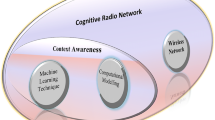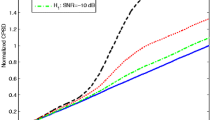Abstract
One of the complex problems nowadays in communication systems is the lack of frequency spectrum. To solve this problem, cognitive radio is considered the best candidate that can opportunistically exploit the spectrum. The periodogram based spectrum sensing technique can be used to detect the spectrum in cognitive radio. It is a useful technique since does not need to prior information about the primary signal. In this paper, a new periodogram is presented using the Discrete Cosine Transform (DCT). Results are analyzed and compared with the current raw periodogram. It is observed that the DCT periodogram outperforms the raw technique in terms of probabilities of false alarm and detection, variance, and complexity. In addition, the lowest power of DCT coefficients can be removed without compromising the sensing performance. The proposed system shows high probability of detection with low probability of false alarm even in the case of low Signal-to-Noise Ratio (SNR).

















Similar content being viewed by others
References
Junfeng, X., Hu, R. Q., Yi, Q., Lei, G., & Bo, W. (2013). Expanding LTE network spectrum with cognitive radios: From concept to implementation. IEEE Wireless Communications, 20, 12–19.
Yue, W.-J., Zheng, B.-Y., Meng, Q.-M., & Yue, W.-J. (2010). Combined energy detection and one-order cyclostationary feature detection techniques in cognitive radio systems. The Journal of China Universities of Posts and Telecommunications, 17, 18–25.
Fragkiadakis, A. G., Tragos, E. Z., & Askoxylakis, I. G. (2013). A survey on security threats and detection techniques in cognitive radio networks. IEEE Communications Surveys & Tutorials, 15, 428–445.
Salman, E. H., Noordin, N. K., Hashim, S. J., Hashim, F., & Ng, C. K. (2016). An overview of spectrum sensing techniques for cognitive LTE and LTE-A radio systems. Telecommunication Systems, 65, 1–14.
Martínez, D. M., & Andrade, Á. G. (2013). Performance evaluation of welch’s periodogram-based energy detection for spectrum sensing. IET Communications, 7, 1117–1125.
Sarvanko, H., Mustonen, M., Hekkala, A., Mammela, A., Matinmikko, M., & Katz, M. (2008). Cooperative and noncooperative spectrum sensing techniques using Welch’s periodogram in cognitive radios. In First international workshop on cognitive radio and advanced spectrum management, 2008. CogART 2008, (pp. 1–5).
Matinmikko, M., Sarvanko, H., Mustonen, M., & Mammela, A. (2009). Performance of spectrum sensing using Welch’s periodogram in rayleigh fading channel. In 4th international conference on cognitive radio oriented wireless networks and communications 2009, (pp. 1–5).
Gismalla, E. H., & Alsusa, E. (2011). Performance analysis of the periodogram-based energy detector in fading channels. IEEE Transactions on Signal Processing, 59, 3712–3721.
Gismalla, E. H., & Alsusa, E. (2012). On the performance of energy detection using Bartlett’s estimate for spectrum sensing in cognitive radio systems. IEEE Transactions on Signal Processing, 60, 3394–3404.
Proakis John, G., & Manolakis Dimitris, G. (1996). Digital signal processing: Principles, algorithms, and applications. Upper Saddle River: Pentice Hall.
Kay, S. M. (1998). Fundamentals of statistical signal processing, volume 2: Detection theory. In A. V. Oppenheim (Ed.), Prentice hall signal processing series. Upper Saddle River: Prentice Hall.
Stevenson, C., Chouinard, G., Zhongding, L., Wendong, H., Shellhammer, S. J., & Caldwell, W. (2009). IEEE 802.22: The first cognitive radio wireless regional area network standard. IEEE Communications Magazine, 47, 130–138.
Yucek, T., & Arslan, H. (2009). A survey of spectrum sensing algorithms for cognitive radio applications. IEEE Communications Surveys & Tutorials, 11, 116–130.
Bhargavi, D., & Murthy, C. R. (2010). Performance comparison of energy, matched-filter and cyclostationarity-based spectrum sensing. In IEEE eleventh international workshop on signal processing advances in wireless communications (SPAWC), 2010, (pp. 1–5).
Liang, Y. C., Zeng, Y., Peh, E. C., & Hoang, A. T. (2008). Sensing-throughput tradeoff for cognitive radio networks. IEEE transactions on Wireless Communications, 7(4), 1326–1337.
Chen, K.-C., & Prasad, R. (2009). Cognitive radio networks. Hoboken: Wiley.
Welch, P. D. (1967). The use of fast Fourier transform for the estimation of power spectra: A method based on time averaging over short, modified periodograms. IEEE Transactions on Audio and Electroacoustics, 15, 70–73.
Ahmed, N., Natarajan, T., & Rao, K. R. (1974). Discrete cosine transform. IEEE Transactions on Computers, C-23, 90–93.
Oppenheim, A. V., Schafer, R. W., & Buck, J. R. (1989). Discrete-time signal processing (Vol. 2). Upper Saddle River, Englewood Cliffs, NJ: Prentice hall.
Bhatial, R. K., Joshi, G., & Anjum, S. R. (2012). Comparison analysis of OFDM signal performance with Cyclic prefix and LDPC codes over AWGN channel. In International conference on advances in engineering, science and management (ICAESM), 2012, (pp. 202–206).
Digham, F. F., Alouini, M. S., & Simon, M. K. (2007). On the energy detection of unknown signals over fading channels. IEEE Transactions on Communications, 55, 21–24.
Author information
Authors and Affiliations
Corresponding author
Additional information
Publisher's Note
Springer Nature remains neutral with regard to jurisdictional claims in published maps and institutional affiliations.
Rights and permissions
About this article
Cite this article
Salman, E.H., Noordin, N.K., Hashim, S.J. et al. An Analysis of Periodogram Based on a Discrete Cosine Transform for Spectrum Sensing. Wireless Pers Commun 101, 1261–1279 (2018). https://doi.org/10.1007/s11277-018-5761-y
Published:
Issue Date:
DOI: https://doi.org/10.1007/s11277-018-5761-y




